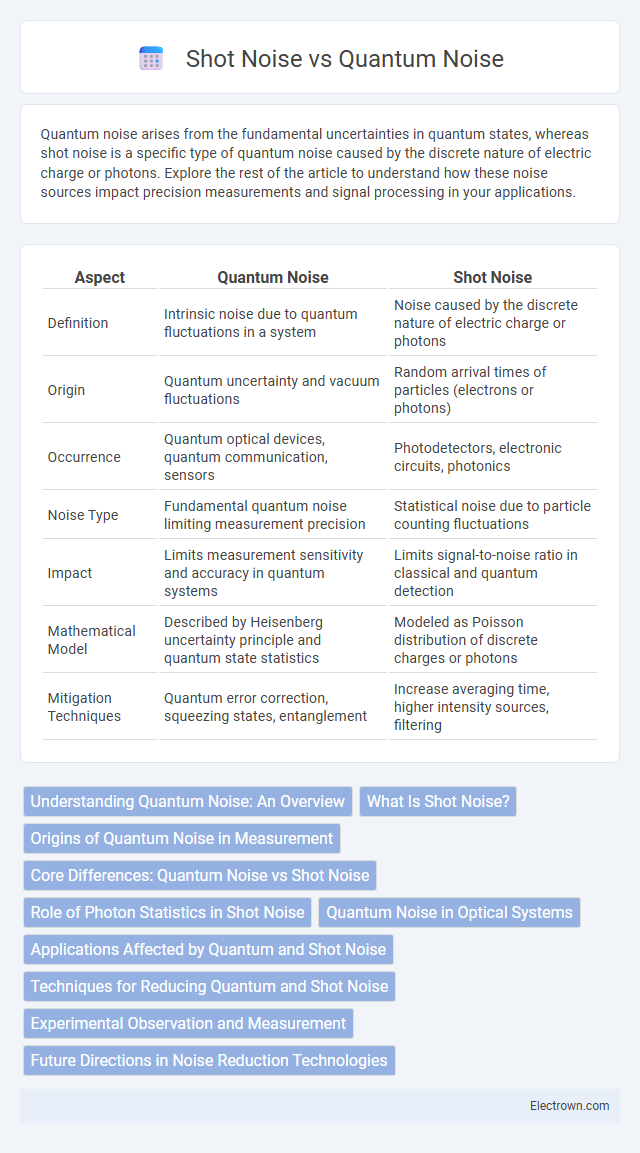Quantum noise arises from the fundamental uncertainties in quantum states, whereas shot noise is a specific type of quantum noise caused by the discrete nature of electric charge or photons. Explore the rest of the article to understand how these noise sources impact precision measurements and signal processing in your applications.
Table of Comparison
| Aspect | Quantum Noise | Shot Noise |
|---|---|---|
| Definition | Intrinsic noise due to quantum fluctuations in a system | Noise caused by the discrete nature of electric charge or photons |
| Origin | Quantum uncertainty and vacuum fluctuations | Random arrival times of particles (electrons or photons) |
| Occurrence | Quantum optical devices, quantum communication, sensors | Photodetectors, electronic circuits, photonics |
| Noise Type | Fundamental quantum noise limiting measurement precision | Statistical noise due to particle counting fluctuations |
| Impact | Limits measurement sensitivity and accuracy in quantum systems | Limits signal-to-noise ratio in classical and quantum detection |
| Mathematical Model | Described by Heisenberg uncertainty principle and quantum state statistics | Modeled as Poisson distribution of discrete charges or photons |
| Mitigation Techniques | Quantum error correction, squeezing states, entanglement | Increase averaging time, higher intensity sources, filtering |
Understanding Quantum Noise: An Overview
Quantum noise arises from the inherent uncertainty in quantum systems, manifesting as fluctuations in measurements due to the probabilistic nature of particles like photons and electrons. Shot noise, a specific type of quantum noise, originates from the discrete and random arrival of particles, primarily in electronic circuits and photodetection processes. Differentiating quantum noise from shot noise is crucial for designing ultra-sensitive instruments in quantum computing, optical communication, and precision metrology.
What Is Shot Noise?
Shot noise is a type of electronic noise that arises due to the discrete nature of electric charge, caused by the random arrival of electrons or photons at a detector. It is fundamentally linked to the particle-like behavior of charge carriers and manifests as fluctuations in the current or signal intensity. Understanding shot noise is crucial for optimizing Your measurement accuracy in low-light or low-current electronic systems.
Origins of Quantum Noise in Measurement
Quantum noise arises from the fundamental uncertainty in quantum states, reflecting inherent fluctuations in the measurement process at the subatomic level. Shot noise, a specific manifestation of quantum noise, originates from the discrete nature of particles such as electrons or photons, causing statistical variations in detection events. Both types of noise limit the precision of high-sensitivity measurements by introducing intrinsic randomness rooted in quantum mechanics.
Core Differences: Quantum Noise vs Shot Noise
Quantum noise arises from the fundamental uncertainty in quantum states, affecting the precision of measurements at the smallest scales, while shot noise results from the discrete nature of particles, such as electrons or photons, causing fluctuations in current or light intensity. Quantum noise encompasses a broader category that includes zero-point fluctuations and vacuum noise, whereas shot noise specifically refers to the statistical variation in particle arrival times. Understanding these core differences helps you design experiments or devices that minimize noise impacts for improved accuracy and sensitivity.
Role of Photon Statistics in Shot Noise
Shot noise arises from the discrete nature of photons and is fundamentally influenced by the statistical distribution of photon arrivals, typically modeled as a Poisson process. Quantum noise encompasses a broader range of fluctuations, including shot noise, but also accounts for quantum uncertainty in field quadratures governed by the Heisenberg principle. The role of photon statistics in shot noise critically determines its intensity fluctuations, directly impacting the signal-to-noise ratio in optical detection systems.
Quantum Noise in Optical Systems
Quantum noise in optical systems originates from the inherent uncertainty in photon detection and electromagnetic field fluctuations, limiting the precision of measurements. This noise manifests as random variations in the amplitude and phase of light, influencing the sensitivity of devices such as interferometers and optical sensors. Unlike shot noise, which arises from the discrete nature of photons, quantum noise encompasses both shot noise and additional effects like vacuum fluctuations, setting fundamental limits on optical communication and quantum computing performance.
Applications Affected by Quantum and Shot Noise
Quantum noise and shot noise significantly impact applications in fields such as quantum computing, optical communication, and precision measurement. Quantum noise limits the accuracy of quantum sensors and quantum key distribution systems, while shot noise predominantly affects photodetectors and low-light imaging systems, restricting signal-to-noise ratios. Both types of noise present fundamental challenges in improving the sensitivity and reliability of advanced technological devices like gravitational wave detectors and semiconductor lasers.
Techniques for Reducing Quantum and Shot Noise
Techniques for reducing quantum and shot noise include the use of squeezing states of light, which manipulate the quantum uncertainty distribution to lower noise in specific measurement quadratures. Employing balanced homodyne detection increases sensitivity by comparing signal and reference beams, effectively canceling out common noise sources. Advanced filtering methods like spectral or temporal filtering isolate the signal frequency band, minimizing shot noise contributions while preserving signal integrity.
Experimental Observation and Measurement
Quantum noise and shot noise are experimentally observed through precise photodetection systems that measure fluctuations in light intensity at the quantum level. Shot noise arises from the discrete nature of electric charge and photon detection, typically quantified by analyzing the statistical variance in photocurrent using sensitive low-noise amplifiers and spectrum analyzers. Your measurements often involve isolating quantum noise by maintaining ultra-low temperature environments and employing high-bandwidth detectors to distinguish it from classical noise sources, ensuring accurate characterization of fundamental noise limits in quantum optics experiments.
Future Directions in Noise Reduction Technologies
Emerging quantum noise reduction technologies leverage squeezed light and entanglement to surpass classical shot noise limits, enhancing precision in quantum sensing and communication. Advances in cryogenic cooling and ultra-low-loss materials enable further suppression of thermal and quantum fluctuations, critical for next-generation photonic devices. Integration of machine learning algorithms optimizes adaptive noise filtering, promising breakthroughs in mitigating both quantum noise and shot noise simultaneously.
quantum noise vs shot noise Infographic

 electrown.com
electrown.com